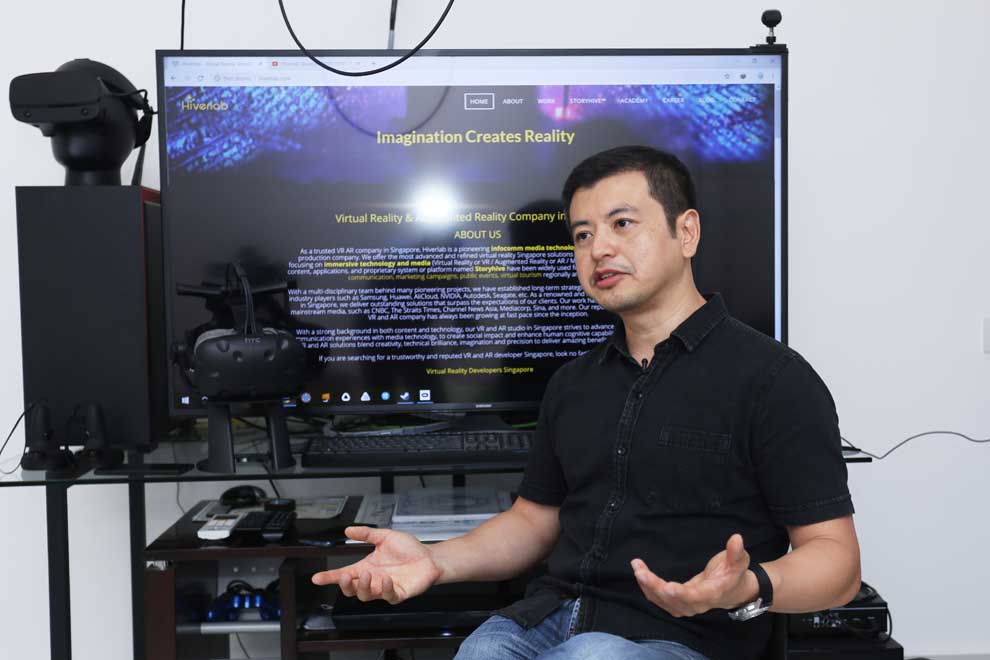
Virtual Reality Cambodia introduced nearly 1,500 children to the technology through their VR Learning Lab EdTech community programme last year. Photo supplied
One minute you’re in Saraboth Ea’s Phnom Penh living room and the next you could be exploring the wonders of the cosmos through a virtual reality (VR) headset.
Saraboth, founder of Virtual Reality Cambodia, is intent on making the innovative technology more accessible to Cambodians who would otherwise not have access to VR.
Few Cambodians had the chance to try out groundbreaking hardware like Facebook’s Oculus Rift and HTC’s Vive prior to Saraboth starting the venture in 2016.
He tells The Post that Virtual Reality Cambodia was borne out of his genuine passion for the technology after he saw first-hand while living in the US its potential to transform people’s interaction with the real world.
“To me, it represents the next evolution of computing technology moving away from viewing content from a small screen, to being fully immersed in a completely new environment where you have a feeling of presence and interaction with the virtual world,” Saraboth says in his living room – which also doubles as a showroom for Virtual Reality Cambodia.
It’s been a long journey for Cambodian-born Saraboth, who fled the country as a refugee – ultimately settling in the US and then returning back home after an absence of 30 years.
He’s intent on democratising extended reality (XR), augmented reality (AR) and VR so that more people are able to see its potential as he had.
In his modest showroom, Saraboth shows off the potential of the pioneering technology. Before you know it, planets and moons are whizzing by you as you guide your journey through the solar system with the aid of a pair of trigger-based controllers.
The work being undertaken by Virtual Reality Cambodia is groundbreaking for the Kingdom, but Saraboth says AR, XR and VR are far more than a novelty.
In a German museum, visitors are able to learn about the atrocities committed during the reign of the Khmer Rouge by going on a 360 degree virtual tour of the notorious Toul Sleng Genocide Museum.

Virtual Reality Cambodia founder Saraboth Ea is intent on making the innovative technology more accessible to Cambodians who would otherwise not have access to VR. Hong Menea
In Singapore, travelers are able to bide their time by experiencing VR training simulations, thanks to a partnership with Singaporean Hiverlabs – which Saraboth is managing director of Hiverlabs Cambodia too.
Saraboth says he’s working to build a stronger ecosystem for the technology so that it can be accessible to a greater number of people back home – that would mean not just providing great hardware, but compelling software too.
Already, potential buyers are able to go on tours of homes thanks to his work – which is alluring for property developers since it opens up listings to buyers in other countries too.
“We use AR to provide 3D property models which can be placed in the real world using smartphones to view mockup models of buildings or room interiors,” says Saraboth.
That way, property developers can sell units to international clients as well, like those in China, Hong Kong, Taiwan, Thailand and Singapore.
As Cambodia’s first VR startup, Saraboth says that Cambodia’s climate is the perfect place to set up shop thanks to the Kingdom’s pivot towards embracing Industry 4.0 and especially the digital economy.
The company was Cambodia’s lone recipient of a grant from Facebook’s Community Leadership Programme – in line with its core mission statement to “give people the power to build community and bring the world closer together”.

“I feel strongly that immersive technologies have a big role in the future of a connected, digital economy, so having policies in place to support and educate people about VR and AR can only be a step in the right direction,”says Saraboth.
To that end, the company introduced nearly 1,500 children to the technology through their VR Learning Lab EdTech community programme last year. They hope to overcome the prohibitively high cost of the technology for most people and have as many Cambodians as possible experience it.
Always looking forward, Saraboth believes that the future lies in nanotechnology as a means to improve the lens, display panel, tracking, and make the hardware and form factors of the VR devices smaller and even more comfortable to use, and perhaps Cambodia would be one of the countries to lead the charge, as long as it integrates courses to foster students’ talents to become the developers of tomorrow.
“It may seem like science fiction, but it’s certainly possible that in the next 50 years or so, humans and digital machines will start to merge and there will be people with augmented implants and technologies that will enhance their physical and mental capabilities,” says Saraboth.
“Cambodia is surprisingly very quick to adopt new technologies and we are working diligently to bring it to more people through creative ways so that they can better realise how they can enjoy and benefit from it. Not only as a means of entertainment, but as a way to connect with one another socially, learn and create content with it,” says Saraboth.
Watch video:












